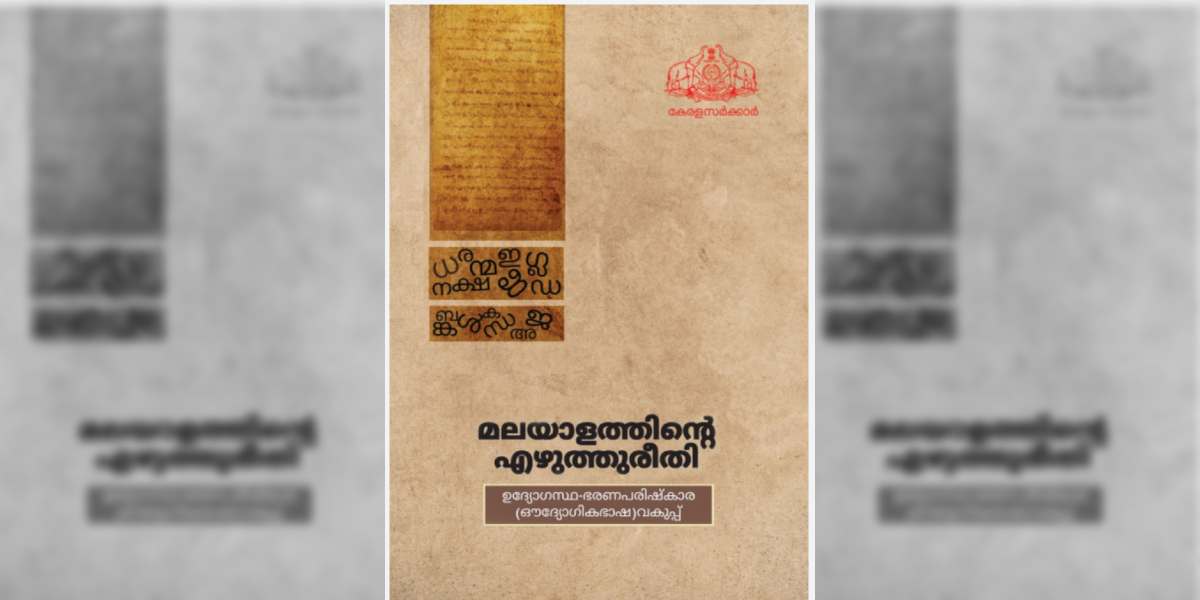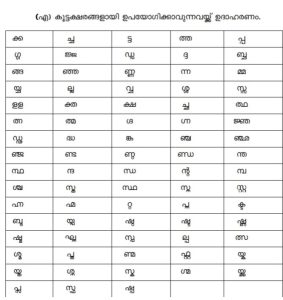Kerala government has prepared a stylebook, 'Malayalathinte Ezhuthureethi', to popularise the changes made to the script.

The cover of the stylebook, 'Malayalathinte Ezhuthureethi' (Supplied)
Padma Ramachandran, then the secretary of the Department of Education in Kerala, issued an order on 23 March 1971, directing all departments to adopt a new Malayalam script for official communication.
A standardised script for printing and typewriting came into effect on 15 April, 1971, the day on which Malayalis all over the world celebrated Vishu, the traditional Malayalam New Year.
Fifty-one years later, Kerala has undertaken a similar exercise. The state has decided to further tweak the Malayalam script.
The move is to bring in a uniform structure to the style of writing — or orthography — in the Malayalam script.
The state government has prepared a stylebook, Malayalathinte Ezhuthureethi (The Style of Writing in Malayalam). The book is now being widely circulated.
The government as well as lovers of the language expect that the restyling of the script will result in establishing a unified Malayalam writing style.
“To set up a unified format in writing style is the need of the hour for a language that enjoys classical language status,” state Chief Secretary VP Joy told South First.
Malayalam was accorded classical language status in 2013.
Joy, himself a poet and writer, has authored more than 20 titles, including two novels.

The dissimilarity in the script is most prominent when it comes to writing certain words that use doubled consonants or conjunct consonants. (Supplied)
The senior-most government official said the dissimilarity in the script is most prominent when it comes to writing certain words that use doubled consonants or conjunct consonants. And it is often confusing.
“People are using all formats of the Malayalam script. While some follow the script that had been in use before the 1971 reforms, others are using the reformed script. Yet some others are using a mix of these two. When it comes to writing, it is confusing,” Joy pointed out.
The government is actively considering another major proposal to promote the standardised script and to set up an electronic dictionary, which the public can access.
“Such a dictionary will help the public to avoid unwanted confusion relating to words. It will help in addressing the problem of people writing the same words differently,” a source said.
Further, the e-dictionary will be updated regularly. “New words will be added after getting the approval of the State Committee for Official Languages,” the source added.
A proposal for standardising the Malayalam script was made to the government on 27 August, 2021. The State-Level Committee for Official Language proposed the setting up of an expert committee to explore the possibility of preparing a unified writing style.
The panel mooted that the standardised script will be in use across the state, including in administration, education, and media.
On 30 October, 2021, the government named a 12-member expert committee. The panel, with the chief secretary as its chairman, began its work on 1 November, 2021.
The committee was directed to submit its recommendations to a high-level panel for official language chaired by the chief minister. The chief minister-led committee accepted the recommendations on 11 April, 2022.
The panel, on 9 May, 2022, directed the chief secretary to expedite the implementation of the proposed changes in all sectors.
Based on the directive, the Personnel and Administrative Reforms Department’s Official Language Section prepared and published stylebook in September. It was printed at the Government Central Press, Thiruvananthapuram.
“We have printed 10,000 copies of the stylebook. It is being distributed to government agencies, media organisations, publishing houses, and others free of cost. If needed, more copies will be printed,” Chief Secretary Joy told South First.
According to the latest version, the Malayalam script has 24 vowels and dependent vowels, 36 consonants, and five cillakṣaraṃ — also chillaksharam — (ർ, ൽ, ൾ, ൻ and ൺ), or cillu (chillu) letters (stop consonants).
Some of the changes listed in the stylebook are:
Four years before Padma Ramachandran issued the order for standarisation of the language in 1971, the then government had set up a committee.
The 1967 panel’s mandate was to study and recommend changes to reform the Malayalam script. Sooranadu PN Kunjan Pillai, then the editor of Malayalam Lexicon (a comprehensive Malayalam-Malayalam-English dictionary), was its convener.
The committee recommended reducing 75 percent of the then-existing characters in print and typewriting.
Another panel constituted in 1969 to expedite the implementation of the Sooranadu Kunjan Pillai committee’s recommendations, made slight changes to the suggestions.
A document, Lipiparishkaranam (The Reformation of Script), was the result of the recommendations of the two committees.
According to linguist Dr VR Prabodhachandran Nayar, a member of the expert committee, the new changes are “minimal”.
“Though the changes are being made after 51 years after the first restructuring of Malayalam script in 1971, they are minimal. Indeed, we have reproduced some of the recommendations this time also,” Nayar told South First.
Before 1971, the Malayalam language had a copious number of characters that went beyond 500, he pointed out. The redemption came when the characters were slashed to 90 in 1971. Now, they have further been reduced to 65.
“It (in 1971) was a sea change. But the changes proposed then were limited to typewriting and printing. It had exempted writing, as it was allowed to continue in the existing format,” Nayar, who pioneered the study of the phonology of Malayalam, added.
The proposed changes will first become visible at the government level and they will then trickle down, the chief secretary said.
“Initially, government institutions, government publications, study materials, including textbooks provided by the State Council of Education Research and Training to schools, and college textbooks will embrace the changes,” Joy said.
He added that publishing and newspaper houses, Malayalam font developers, and others have been told to make the changes.
Meanwhile, author, and literary critic Dr P Soman, another member of the expert committee, said that the target group is children, as they are the future generation.
“Adults are unlikely to follow the changes. They are accustomed to the script that is in force since 1971. Thus, the target group should be children. And the change should begin from the schools,” Soman told South First.
He, however, hastened to add that a timeframe cannot be set for making the population accept the changes.
“It might take some time for them to grasp these changes. They must get used to it. Only then we could realise the dream of standardisation in writing. But when it will happen, it’s anybody’s guess,” Soman added.
The promotion of uniformity and consistency in a language entails the reduction or elimination of variation. It has also been pointed out that the standard language habituated — particularly in written mode — is usually held in high prestige.
There are four types of letters or syllables in Malayalam: Initial vowels, consonants, dependent vowels added to consonants, and combining consonants for conjunct sounds.
Malayalam, as a literary language, has existed for over 10 centuries. According to an expert committee that granted classical language status to Malayalam, its language and literature were about 1,500 to 2,000 years old.
Inscriptions dating to the 2nd and 5th century CE were noted, and it was concluded that the Malayalam language had a body of ancient literature and an original literary tradition and heritage, which is at least a thousand years old.
Rajasekhara’s Vaazhappalli inscription of the 9th century was considered to be the first inscription of independent Malayalam.
Manipravaala was an innovation in the style of literary writing in Malayalam without parallels in other Dravidian literary languages. It also had a body of respected literature since the 12th century.
It was upon considering these aspects that the Union Cabinet on May 23, 2013, approved classifying Malayalam as a “Classical Language”.
The Malayalam script is phonetic (you say it as you write it) as well as syllabic (it’s based on a letter and the syllables you can make with a letter).

Apr 26, 2024

Apr 26, 2024

Apr 26, 2024

Apr 25, 2024

Apr 25, 2024

Apr 25, 2024